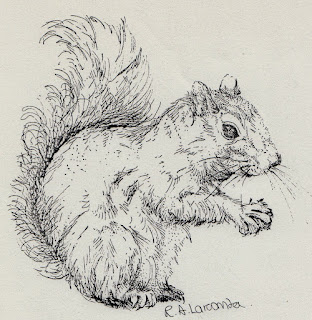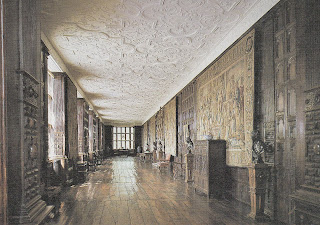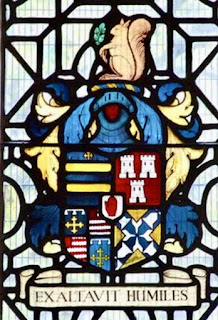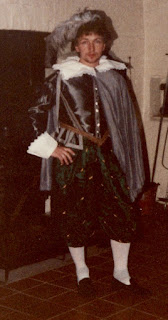Aston Hall & Teaching There…
One of the initial requests I received whilst working in the Schools Liaison Department of Birmingham Museums was to prepare myself for a few teaching sessions at Aston Hall. The Jacobean mansion which sits in Aston Park, sandwiched between my old secondary school and Aston Villa’s football ground, had been built between 1618 & 1635 for Sir Thomas Holte, who had enclosed parkland in Aston whist living at nearby Duddeston Manor.
 |
| 1656... |
Despite having attended King Edward’s Grammar School at the top end of Aston Park and later possessing a season ticket at Villa Park at the lower end of the grounds, incredibly I had never once set foot in Aston Hall. I had done cross-country runs around it, thrown snowballs near the house and had used the slopes leading from it for sledging upon during a couple of snowy winters until an idiot broke his arm. My father parked his car outside the school when attending Villa matches too and we had walked right past the entrance of the house on many occasions…
 |
| 1744... |
Originally, where Villa’s football ground is now sited was the Holte family’s cess pit, for all waste would run down the parkland slopes and collect in a boggy area well away from the Hall…
Now if you’ve ever wondered why Villa have sometimes played like shit at home, that could possibly be one of the reasons…
However, my brief was to prepare a tour of the house for some difficult groups of secondary pupils from Perry Common Comprehensive School, Year 9 or 10 I believe and so I drove to Aston Hall and met its superintendent, John Heylings, ‘Mr Aston Hall’.
Luckily he and I gelled and he was kind enough to give me the sort of tour which he used for booked groups of adults at weekends or during some evenings. Added to his anecdotes, I took information from the accepted histories of the house but most of all from my own observations, thinking of what might interest some awkward, possibly unruly teenagers.
The groups were each of about a dozen pupils and the ‘tours’ would last for about 75 minutes, after the kids had made their own way to the Hall by bus. They would meet the teacher at the main entrance and she was a mild lady who one could only guess had ‘drawn the short straw’…
After John Heyling’s retirement and when Oliver Fairclough left his curatorial post for pastures new, I remained as the only person who really knew stuff about Aston Hall, which was a trifle odd. However, that first session with Perry Common began in a dreadful manner because of one unpleasant teenager who was clearly a real troublemaker.
The teacher had already met several of the pupils and I watched them being herded towards the Hall’s entrance but she was apparently enquiring of the others where three missing girls might have got to. I met the group at the door and the teacher asked me to hang onto them while she went in search of the stragglers. I took the kids inside the Entrance Hall and I kept an eye on the teacher through the windows as she hurried away but the missing girls came into sight almost immediately.
However, I had introduced myself to the pupils inside the Entrance Hall and had added that I would try to make sure that I didn’t bore them, at which point one lad spat out the words, “I’m bored already…”
 |
| THE ENTRANCE HALL... |
Now I should remark here that I have a lot of patience with other folks and possess barely any kind of bad temper but I knew I would be judged on my next move by the lad, his classmates and also the security guards Pete and Phil who were hovering, waiting for the teacher to sign in with her name and how many kids she had in tow.
My turn on that kid was fast and I moved to within centimetres of him, bellowing into his rather shocked and terrified face: “I haven’t even started yet… How dare you speak at me like that…” He was thus forced to retreat towards the windows and I covered his movements, staying close to him and glaring into his eyes… His peers became silent, Pete and Phil exited the room with some haste and they told me afterwards that they thought I was going to beat the lad up…
I didn’t need to be physical though because he feared me and of course when the teacher and her three mardy stragglers arrived, she commented on how well the others were behaving, casting a surprised glance at the silent, sullen boy I had castigated. I had to deal with the signing-in book though, for the two security guards hadn’t returned to the entrance from hiding in their mess-room. And then I began my tour…
The session went really well and the pupils experienced a real mixture of humour, conversation and relevant anecdotes, without any need for more than a few dates and little of the typical historical jargon often blurted out by guides in other mansions and properties, none of which would have meant anything to youngsters like those. They were terrified too, by one or two ‘haunted house’ references…
The kids were great to work with, even the lad I had clashed with earlier and as the group was about to leave the teacher expressed her gratitude to me. The kid who had cheeked me when the group had arrived hung back however and duly apologised for what he had said, which surprised me and he also told me that he had enjoyed a great time. “You weren’t bored, then?” I asked. He shook his head with a smile and we shook hands…
I would teach a few more Perry Common groups at Aston but there was never a problem because I think that word might have got round that the pupils would enjoy their afternoon out of mainstream teaching…
I would later teach the same Perry Common groups about ancient Egypt in the Museum & Art Gallery and they loved those sessions too, which I will discuss in a future article…
 |
| THE SERVANTS' BELLS, WHICH ALWAYS CREATED CONVERSATION... |
So, the Aston Hall tour was a delicate balance between fact, legend and observation and conversation, which worked well with the Perry Common youngsters. We chatted about changes made to areas such as the Great Parlour, which was originally used for family dining but had then been converted into a chapel in 1700, its floor being lowered by about a metre. It then reverted to being a parlour in 1870 and the floor was raised again. Legend has it that human remains were found at that time… The pupils were already using their imaginations…
 |
| GREAT PARLOUR... |
At the foot of the Great Stairs there was a wooden chair but when I asked the class: “When is a chair not a chair?” the kids looked quizzically at me and I would then ask one of them to take hold of the right armrest and pull… To everyone’s surprise it began to reveal a space behind and I then continued: “When it’s a door…” Gosh, they loved that and conversations began about whether it was a hiding place for priests, or perhaps the entrance to a secret passage. I would then chip in with: “Or simply a cupboard…”
 |
| GREAT STAIRS... |
 |
| THE CHAIR/DOOR... |
Having seen the less decorated Oak Staircase later during the tour, we would discuss why the Great Staircase was so lavishly carved. A clue was that guests would be taken up those stairs to the Great Dining Room and of course the kids would quickly suggest that the route was meant to impress the diners, whilst the other stairs were for the use of servants and staff, offering a glimpse of the hierarchy in Aston Hall in the class conscious society of the 17th century.
 |
| OAK STAIRS... |
It was said that the housekeeper would show guests some damage to the upper section of the staircase, telling them that it was Civil War cannonball damage from when the Hall came under attack from Parliamentarians on 18th December 1643. In truth however, it is tough to confirm that legend because of the lack of visible damage elsewhere, even to the outside walls. The cannons were apparently also fired from a position which would make the chances of striking the main staircase inside the Hall rather slim. But who knows?
 |
| THE LEGENDARY DAMAGE... |
We looked for two animal representations in the decoration of the house too: the Holte family’s squirrels and the younger James Watt’s elephants. Watt lived at Aston Hall in the 19th century. The animals could be spotted carved from wood and also of course in the plaster work on and close to ceilings. Discussing furniture, pottery and paintings were not options during those tours because it was imperative not to ‘bore’ the listeners with endless names of artists and dates of items which weren’t even displayed in Aston Hall during its heyday. We did discuss the size of family portrait paintings though, by me asking if the pupils had photos of themselves or their families on the walls of their homes. They would of course usually admit that yes, they did but they soon realised that with no photography in the distant past, artists had to paint portraits to fit the heights of walls in mansions… Obviously we would then chat about sittings for artists and the time taken to complete family portraits, during which time one or more of the subjects could conceivably have died before the paintings had been completed…
 |
| ONE OF THE HOLTE SQUIRRELS... |
One carved profile upon the fine fireplace in the Great Dining Room always looked remarkably like Queen Victoria to me, who, along with husband Prince Albert visited Aston Hall in 1878. A toilet had to be installed for her use too but she didn’t use it… The kids liked that story, especially as I would open the door of the said closet which at that time contained the controls for lights and alarms, etc.
 |
| QUEEN VICTORIA AT ASTON HALL ON 15TH JUNE, 1858... |
 |
| QUEEN & CONSORT IN THE KING CHARLES BEDCHAMBER... |
 |
| QUEEN AND CONSORT IN THE GREAT DINING ROOM, WHICH WAS LATER JAMES WATT'S LIBRARY... |
King Charles I slept one night at Aston Hall, on 18th October 1642, en route from Shrewsbury to London and of course the room where he slept has become ‘King Charles I’s Bedchamber’. A copy of a fine and recognisable painting of the King actually covered a complete window in that room when I taught at Aston. Strangely, due to the fact that Sir Thomas’ son Edward had married against his father’s wishes, Sir Thomas disinherited Edward, even though the son actually held a privileged position as groom of the King’s bedchamber, until he died of fever at the Royalists’ headquarters in Oxford. Edward had been injured at the battle of Edgehill on 23rd October 1643 but then died just five days later.
 |
| THE KING CHARLES BEDCHAMBER... |
 |
| EDWARD HOLTE... |
The pupils were shocked that in one Drawing Room, there was flock wallpaper, made to replicate a small piece of the original decoration found in the room in the early 1980s. After the copied wallpaper was completed, each roll cost Birmingham Museums £200 and there were thirteen of them used…
A discussion would always be lively at this point because of the idea of a ‘withdrawing room’, to where male guests would retire after dinner, to smoke, drink and converse, whilst women would likely remain in the dining room. The opinions of girls in particular would often become feisty and I would always agree with them…
The Long Gallery was always liked by visitors because of its brightness and its remarkable wooden floor. Just looking at it, gazing along it and regarding its typically splendid ceiling and general decoration needed no words or urgings like ‘look at this’ or ‘look at that’… Learning that the gallery was used for leisure, such as walking and exercising when the weather was inclement, always seemed to surprise visitors. Clearly the gallery was positioned so that as much sunlight would be shining on it during the day as possible. However, the coat of arms on the window became a talking point, for it contained a bloody hand…
 |
| THE FINE LONG GALLERY... |
Thomas Holte was knighted when he was one of a number of influential fellows who travelled north to welcome Scotland’s James VI into England to become James I here, following the death of Elizabeth I in 1603. That title apparently cost Thomas £100 but he was later well off enough to buy the title of Baronet too, which gentlemen were invited to do, so that the King would be able to fund soldiers to suppress uprisings in Ireland. This time, Sir Thomas dished out £1095… He was the 97th of 200 Baronetcies handed out by the King on 25th November 1611. The bloody hand was thus painted onto the coats of arms of contributors to the blood shed by the Irish in fatal skirmishes…
 |
| THE BLOODY HAND APPEARS... |
The kids were always shocked by that but then I would tell them about Sir Thomas’ cook at his previous home in Duddeston…
The story has some truth in it certainly, for Sir Thomas was accused of cleaving his chef’s skull into two pieces, each section dropping onto his shoulders beneath…
It appears that Sir Thomas had been out hunting with a group of friends and he was boasting that his chef was excellent and a fine timekeeper. He told his peers that he knew exactly what his chef would be doing when the party returned to his home, which was at that time at Duddeston Hall and of course Sir Thomas expected his forecast to be correct.
However, the chef wasn’t where Sir Thomas had bet his friends that he would be and due to the embarrassment and humiliation caused in front of the company, he eventually lost his temper and cleaved the chef’s head. Or so the tale went…
However, Sir Thomas took William Ascrick (spelt in many ways) to court on 13th July 1608 for his slanderous accusations about the assault and although damages of £1000 were asked for when the accused was found to be guilty, Sir Thomas only won £30. Ascrick soon appealed to the Court of King’s Bench however, which because no accusation of actual murder had been brought by the defendant against Sir Thomas, the judgement went in favour of Ascrick. It was a loophole, for no mention of a dead body had been made and indeed, the cook might well have been alive, so the appeal succeeded…
Maybe Sir Thomas got away with one there, for incredibly he later acquired a pardon from King Charles I for previous misdemeanours and even suspicions of the same! It seemed that being a landowner and quite rich, not to mention being a Knight and a Baronet served him well…
The Nursery in Aston Hall contained some toys which would always trigger conversations about comparisons with today and how playing has changed so much since those days.
Dick’s Garret, a loft, or attic at the top of the house was very popular with visitors, partly because of the armour on display and I guess that the forty Royalist musketeers sent from Dudley Castle, who manned the house when it was attacked in 1643 would have spent time there…
 |
| DICK'S GARRET... |
However, there is a legend that Sir Thomas locked one of his daughters inside a small room off the Garret because she had refused to marry the fellow chosen for her. The story goes that she was obstinate and continued to refuse the marriage, not eating and eventually passing away. It is her ghost which has been reported walking though the Hall, dressed in green…
It is worth remembering though that Sir Thomas wanted to disinherit his son Edward for making a marriage of his own choice, to the irritation of the King himself…
Descending the less ornate oak staircase, the pupils would be shown the Servants’ Hall and the Kitchen, as well as the servants’ own staircase, which of course would have been used whilst food was being carried to dinner guests, despite the spiral nature and narrowness of the steps. Questions about the probability of food remaining hot were often asked…
 |
| THE SERVANTS' HALL, ONCE THE KITCHEN... |
The Servants’ Hall housed a brilliant box mangle, a huge thing which would have needed some muscle in order to turn the handles of and squeeze excess water from washed laundry. Despite ignoring most dates or even discussing the ages of various items of furniture and paintings, I would always point out the oldest item in the house which was situated in the Servants’ Hall, a 14th century wooden chest.
On into the Kitchen we would walk together and the conversation would really take off into a comparison between what was in that room to what the students were used to at home. Items regularly discussed included the meat safe, the spit, the pestles and mortars, the predominance of meat eating and of course yet another huge fireplace, the smoke from which would be added to by the other fireplaces already seen in the Hall, doubtless causing woodsmoke to billow across Aston’s lower grounds…
 |
| THE KITCHEN & TURTLE SHELL... |
A giant turtle shell on one wall was always commented upon, even though it had no relevance to Aston Hall at all, it not being a squirrel or an elephant. It had once been on display in Birmingham’s Museum…
The kids were also surprised to learn that the ends of the two arms of Aston Hall which jutted out from the front of the house were lived in at that time by security staff and their families…
 |
| THE LODGES PROTRUDE AT THE FRONT OF THE HOUSE... |
Aston Church was clearly visible at the bottom of the hill and as everyone was expected to attend Sunday services in the 17th century, it became clear to the students that the servants would walk down to the church, then uphill back to the house, whilst family members would likely be transported each way by horse-drawn carriage.
The tour ended with mentions of the Entrance Hall and the Gatehouses, from anecdotes relayed to me by John Heylings. First, he had told me that once he was about to begin a tour of the house with an adult group and he was standing near the arch in the Entrance Hall welcoming the visitors. Quite suddenly, he felt himself being lifted from his body towards the windows opposite and for several moments he watched himself speaking to the guests. His spiel continued as he watched, until he felt himself lifted over the heads of the visitors again and back into his suited torso…
 |
| THE GATEHOUSES... |
Maybe sometime in the period from the 1920s to the 1950s, it was said that a nightwatchman who had been posted in the gatehouse (sadly demolished in 1959) was disturbed during the dark hours of one night by a light shining from inside the windows of the locked Hall at the top of the incline, which appeared to slowly shift between areas.
The legend was that the fellow took his lantern and went to investigate but was found dead on the grassy area outside the main entrance early the following morning. He had an expression of fear on his face and the main door of the house was as wide open as his eyes…
Many years later when the house was fully alarmed, security was alerted one night when several alarms went off, one after the other. First the Entrance Hall, then the Oak Stairs and then the Long Gallery, as if someone or something had intruded… After being reset, the alarms soon went off again but in reverse order, which apparently confounded the staff. No sign of an intrusion by humans or other animals was ever discovered…
So, in the autumn of 1984 I decided to try to put together a 17th century Christmas session for Key Stage Two pupils and it became one of the best decisions I ever made in my working life.
 |
| SIR THOMAS HOLTE... |
I would actually BE Sir Thomas Holte, the man born in 1571, a student at Magdalen College, Oxford, a Knight and a Baronet.
 |
| ME AS SIR THOMAS HOLTE... |
He outlived all but one of his sixteen children, dying in 1654…
 |
| A PUPIL'S IMPRESSION OF ME AS SIR THOMAS HOLTE... |
 |
| ADVERT FOR CHRISTMAS REVELS, DECEMBER 1859... |





No comments:
Post a Comment